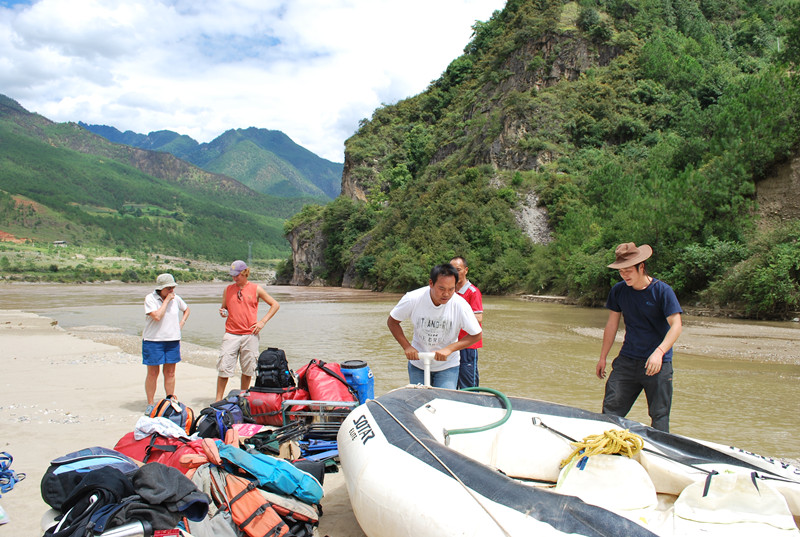
Rafting Travel Guide of Jinsha-Yangtze River in Yunnan
Jinsha River Rafting Guide
The Jinsha River, located in southwest China, is an upper reach of the Yangtze River flowing through Sichuan and Yunnan provinces. Named for its golden sand and known for its swift currents and numerous rapids, it’s hailed as the “top rafting destination in the East.” With increasing tourism, more visitors seek to explore the Jinsha River, experiencing nature’s awe-inspiring landscapes. Here’s how you can enjoy a relaxed rafting experience on the Jinsha River, bidding farewell to thrill and mastering the art of navigating its waters.
Choosing the Right Rafting Equipment: When rafting on the Jinsha River, you can opt for different types of rafts such as rubber rafts or inflatable boats. Rubber rafts offer stability and are suitable for beginners and family outings, while inflatable boats are lighter and ideal for more experienced rafters. Alternatively, you can choose a sightseeing boat to enjoy the scenic views along the way. Ensure whichever rafting equipment you choose is safe and reliable to ensure your safety throughout the journey.
Understanding the Terrain and Topography: The Jinsha River is dotted with natural obstacles like rapids, reefs, and whirlpools. Understanding these features helps you navigate safely during the rafting adventure. Before embarking, consult local travel agencies or the scenic area for information on the river’s terrain and topographic characteristics. Watching videos of other rafting experiences can also provide practical insights into navigating the Jinsha River.
Mastering Basic Rafting Techniques: To ensure a safe rafting experience on the Jinsha River, it’s essential to master some basic techniques:
- Maintain Balance: Keep your body balanced during the rafting journey to prevent capsizing. Stand with your feet apart and hold onto the boat’s edges to maintain stability.
- Monitor Water Currents: Stay vigilant about changes in water currents to adjust your boat’s direction promptly. Reduce speed in advance when approaching rapids or reefs to avoid collisions.
- Learn Paddling Techniques: If using a rubber raft or inflatable boat that requires paddling, learn proper paddling techniques. Maintain alignment between your body and the boat’s center of gravity, apply even force, and avoid sudden movements to prevent capsizing.
- Adhere to Safety Regulations: Follow safety regulations set by the scenic area, such as wearing life jackets and refraining from diving without permission. Listen to guides or staff instructions to ensure your safety throughout the journey.
Maintaining a Positive Attitude: During your rafting journey on the Jinsha River, you may encounter thrilling and challenging scenarios. Maintaining a positive attitude is crucial. Stay calm when facing obstacles like rapids or reefs, trust your judgment and skills. Engage with fellow rafters to share experiences and enhance the enjoyment of rafting.
In conclusion, with the right rafting equipment, understanding of the river’s terrain, mastery of basic techniques, and a positive mindset, you can enjoy a relaxed and memorable rafting experience on the Jinsha River. Embrace the marvels of nature and challenge yourself, ensuring your journey on the Jinsha River becomes an enjoyable and safe adventure!

 7 Days GolfingTour
7 Days GolfingTour
 8 Days Group Tour
8 Days Group Tour
 8 Days Yunnan Tour
8 Days Yunnan Tour
 7 Days Shangri La Hiking
7 Days Shangri La Hiking
 11 Days Yunnan Tour
11 Days Yunnan Tour
 6 Days Yuanyang Terraces
6 Days Yuanyang Terraces
 11 Days Yunnan Tour
11 Days Yunnan Tour
 8 Days South Yunnan
8 Days South Yunnan
 7 Days Tea Tour
7 Days Tea Tour
 8 Days Muslim Tour
8 Days Muslim Tour
 12 Days Self-Driving
12 Days Self-Driving
 4 Days Haba Climbing
4 Days Haba Climbing
 Tiger Leaping Gorge
Tiger Leaping Gorge
 Stone Forest
Stone Forest
 Yunnan-Tibet
Yunnan-Tibet
 Hani Rice Terraces
Hani Rice Terraces
 Kunming
Kunming
 Lijiang
Lijiang
 Shangri-la
Shangri-la
 Dali
Dali
 XishuangBanna
XishuangBanna
 Honghe
Honghe
 Kunming
Kunming
 Lijiang
Lijiang
 Shangri-la
Shangri-la
 Yuanyang Rice Terraces
Yuanyang Rice Terraces
 Nujiang
Nujiang
 XishuangBanna
XishuangBanna
 Spring City Golf
Spring City Golf
 Snow Mountain Golf
Snow Mountain Golf
 Stone Mountain Golf
Stone Mountain Golf

















